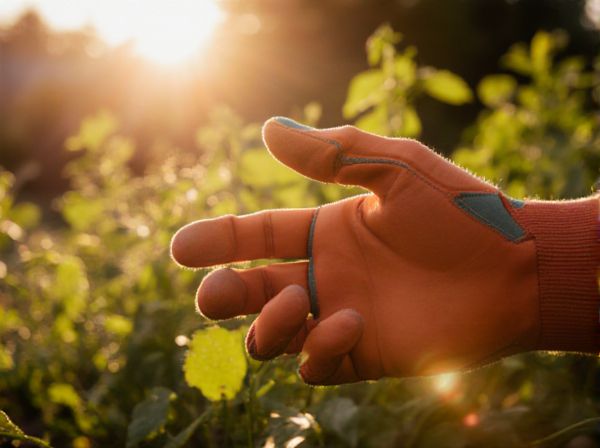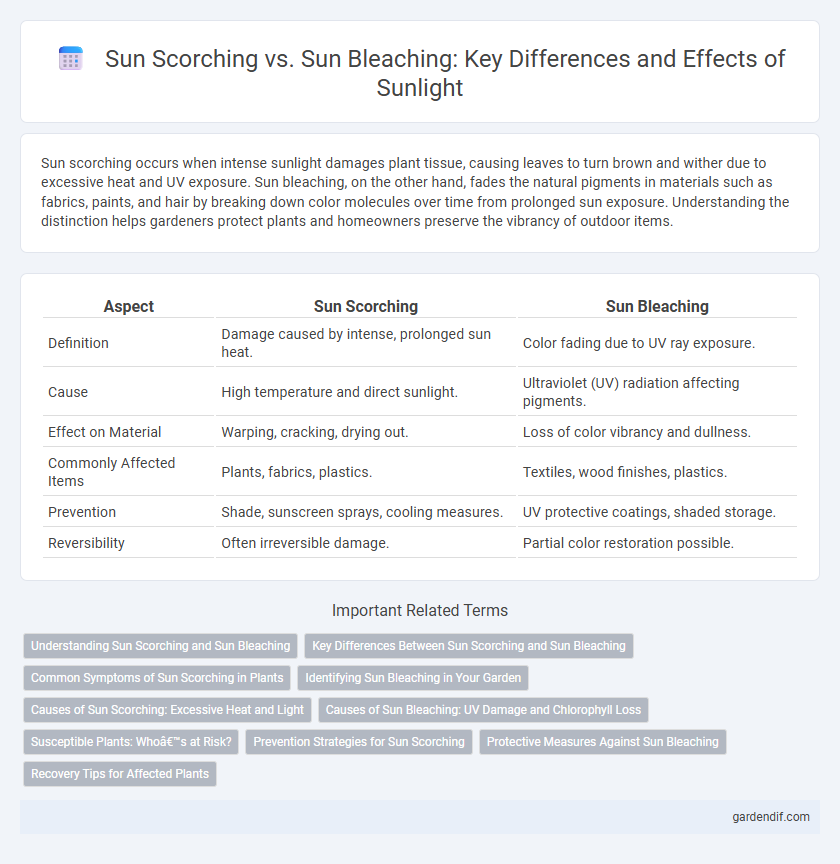
Sun Scorching vs Sun Bleaching Illustration
Sun scorching occurs when intense sunlight damages plant tissue, causing leaves to turn brown and wither due to excessive heat and UV exposure. Sun bleaching, on the other hand, fades the natural pigments in materials such as fabrics, paints, and hair by breaking down color molecules over time from prolonged sun exposure. Understanding the distinction helps gardeners protect plants and homeowners preserve the vibrancy of outdoor items.
Table of Comparison
| Aspect | Sun Scorching | Sun Bleaching |
|---|---|---|
| Definition | Damage caused by intense, prolonged sun heat. | Color fading due to UV ray exposure. |
| Cause | High temperature and direct sunlight. | Ultraviolet (UV) radiation affecting pigments. |
| Effect on Material | Warping, cracking, drying out. | Loss of color vibrancy and dullness. |
| Commonly Affected Items | Plants, fabrics, plastics. | Textiles, wood finishes, plastics. |
| Prevention | Shade, sunscreen sprays, cooling measures. | UV protective coatings, shaded storage. |
| Reversibility | Often irreversible damage. | Partial color restoration possible. |
Understanding Sun Scorching and Sun Bleaching
Sun scorching occurs when intense sunlight damages the outer cellular layers of plants, causing leaves to develop dry, brown patches due to excessive heat and UV exposure. Sun bleaching, on the other hand, refers to the fading or discoloration of materials such as fabrics, plastics, or hair caused by prolonged ultraviolet radiation breaking down pigments. Understanding the distinct mechanisms behind sun scorching and sun bleaching helps in implementing proper protective measures for both living organisms and sensitive materials exposed to strong sunlight.
Key Differences Between Sun Scorching and Sun Bleaching
Sun scorching refers to damage caused by intense heat and ultraviolet (UV) rays from the sun, leading to effects such as wilting or tissue damage in plants and materials. Sun bleaching involves the fading or discoloration of materials, especially fabrics and paints, due to prolonged exposure to sunlight and UV radiation. The key difference lies in scorching causing physical damage and heat stress, while bleaching primarily results in color degradation and loss of vibrancy.
Common Symptoms of Sun Scorching in Plants
Sun scorching in plants typically presents as brown, crispy leaf edges and irregular patches of dead tissue on leaves exposed to intense sunlight. Affected foliage often exhibits wilting, yellowing, and brittle texture due to cellular damage from excessive ultraviolet radiation and heat. Prolonged sun scorching can lead to stunted growth and reduced photosynthetic efficiency in affected plants.
Identifying Sun Bleaching in Your Garden
Sun bleaching in your garden is characterized by faded or washed-out colors on leaves, petals, and outdoor furniture, unlike sun scorching which causes brown, crispy edges or spots due to cellular damage. Identifying sun bleaching involves observing consistent discoloration where surfaces appear bleached or pale without tissue death, often affecting plant foliage and fabrics exposed to prolonged sunlight. Monitoring areas with intense direct sunlight and comparing them to shaded zones helps distinguish sun bleaching from other types of sun damage.
Causes of Sun Scorching: Excessive Heat and Light
Excessive heat and intense ultraviolet light from the sun cause sun scorching by damaging plant cells and tissues, leading to dehydration and cell death. This stress disrupts photosynthesis and results in browning or wilting of leaves. Prolonged exposure to high temperatures intensifies water loss and exacerbates cellular damage, making plants more susceptible to sun scorching.
Causes of Sun Bleaching: UV Damage and Chlorophyll Loss
Sun bleaching primarily results from prolonged exposure to ultraviolet (UV) radiation, which damages plant tissues and degrades pigments. UV damage disrupts chlorophyll molecules, leading to the loss of green coloration and causing leaves or fabrics to appear faded or bleached. This chlorophyll loss diminishes photosynthetic efficiency and visibly alters the color intensity of affected surfaces.
Susceptible Plants: Who’s at Risk?
Susceptible plants to sun scorching often include tender or shade-loving species such as begonias, ferns, and impatiens that experience leaf damage and wilting when exposed to intense, direct sunlight. In contrast, plants at risk of sun bleaching, like hydrangeas, azaleas, and certain succulents, display faded or discolored foliage caused by prolonged UV radiation and heat stress. Understanding the specific vulnerabilities of these plants helps gardeners implement protective measures to prevent sun damage and maintain healthy growth.
Prevention Strategies for Sun Scorching
Sun scorching results from prolonged exposure to intense solar radiation causing tissue damage, requiring prevention strategies such as applying broad-spectrum UV-blocking sunscreens with high SPF, wearing protective clothing like wide-brimmed hats and UV-filtering sunglasses, and seeking shade during peak sunlight hours between 10 a.m. and 4 p.m. using physical barriers or UV-protective films on windows. Hydration is essential to maintain skin resilience, while avoiding reflective surfaces like sand or water reduces the risk of intensified UV exposure. Regular reapplication of sunscreen every two hours and after swimming or sweating is critical for effective protection against sun scorching.
Protective Measures Against Sun Bleaching
Sun bleaching occurs when prolonged exposure to ultraviolet (UV) rays breaks down the chemical bonds in dyes and pigments, causing colors to fade and materials to weaken. Protective measures against sun bleaching include applying UV-resistant coatings, using fabric covers or shades, and selecting materials with inherent UV protection for outdoor furniture and textiles. Regular maintenance, such as rotating items and storing them away from direct sunlight during peak hours, also significantly reduces the risk of sun bleaching damage.
Recovery Tips for Affected Plants
Sun scorching causes irreversible damage to plant leaves, but affected plants can recover with proper care such as increased watering, shading, and applying foliar sprays with seaweed extract to promote healing. Sun bleaching, often seen as faded or pale foliage, can be mitigated by gradually acclimating plants to direct sunlight and ensuring balanced soil nutrients including magnesium and iron. Ensuring optimal hydration and avoiding sudden exposure to intense light are key strategies in restoring plant health after sun damage.
Sun Scorching vs Sun Bleaching Infographic

 gardendif.com
gardendif.com